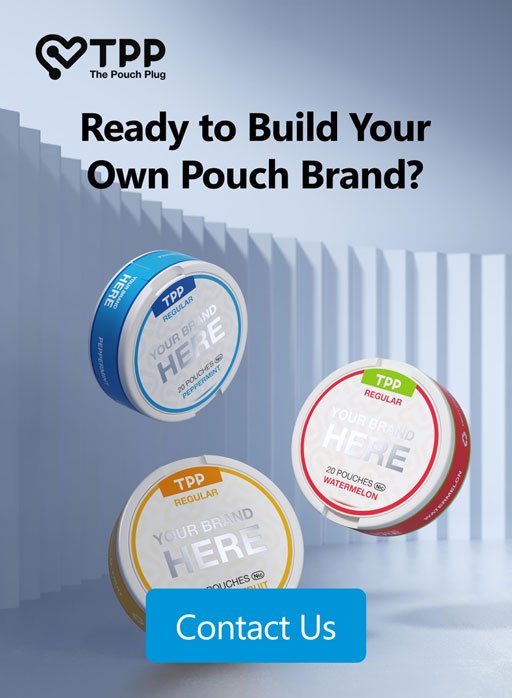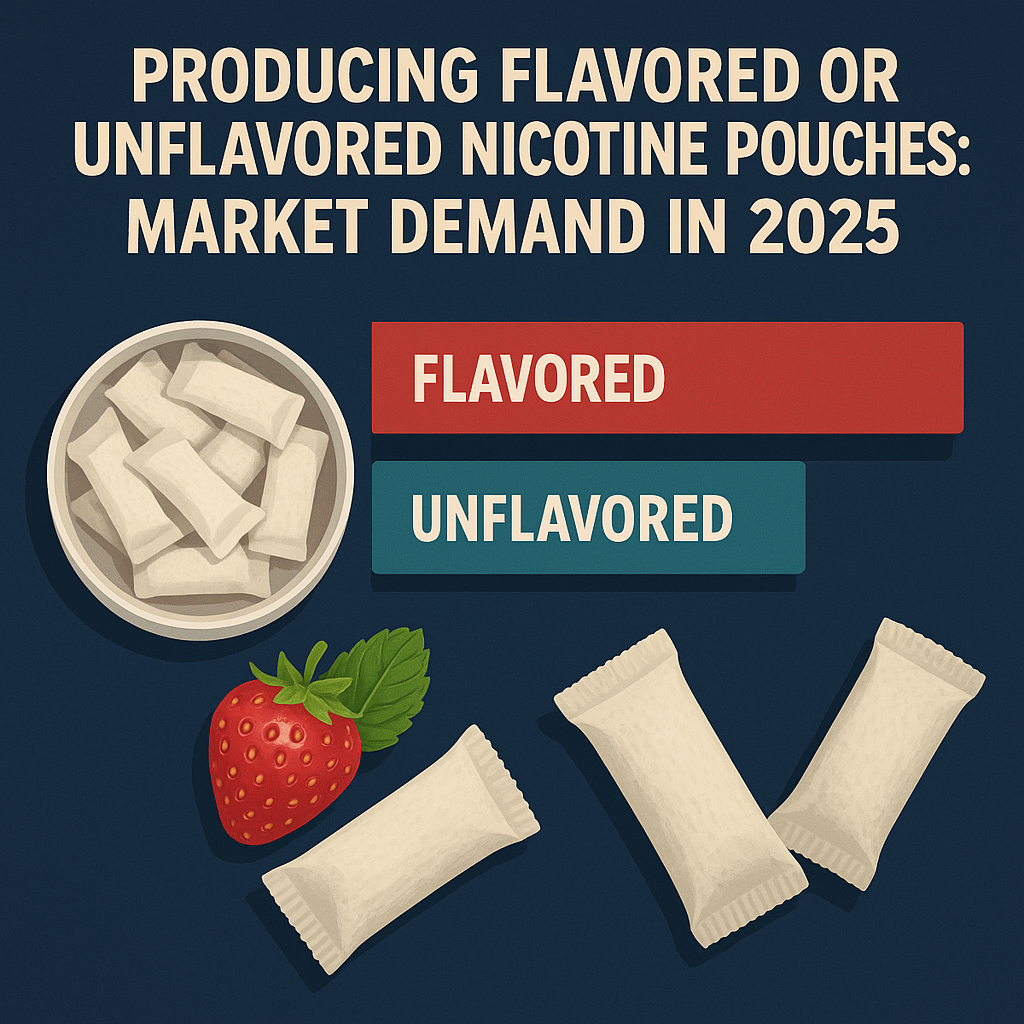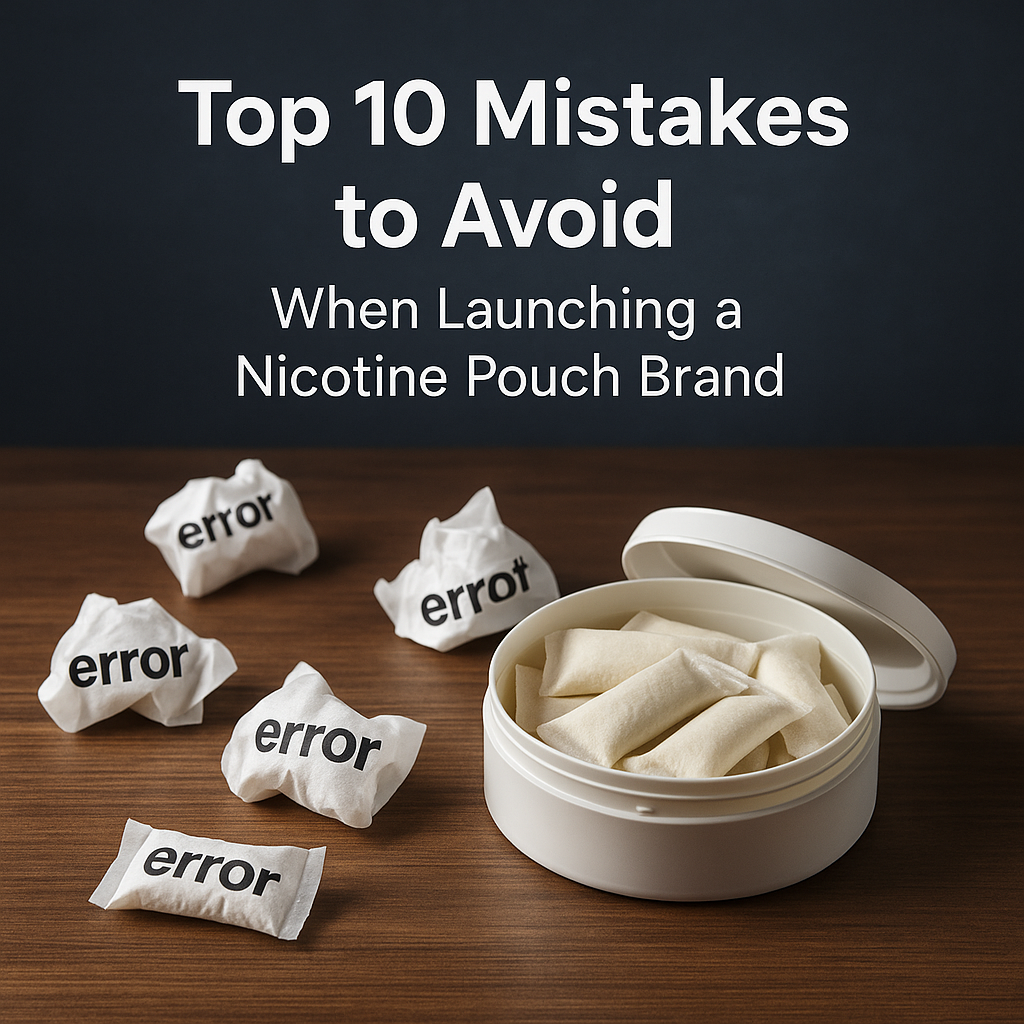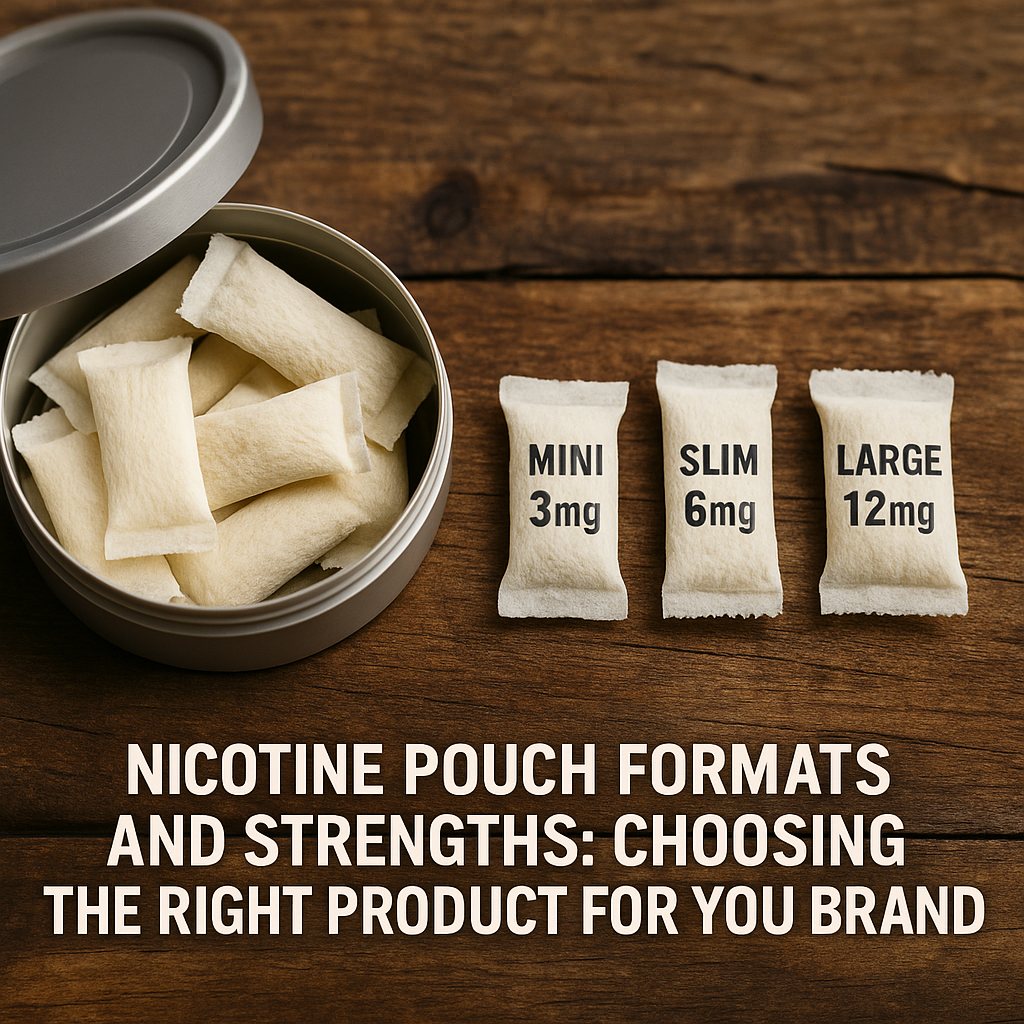Nicotine pouches have exploded as a smoke-free alternative in recent years. These small, plant-fiber packets—sometimes called “white snus”—contain nicotine, sweeteners, and flavorings, but no tobacco. The global market was about $5.4 billion in 2024 and is forecast to nearly quintuple by 2030 (to ~$25.4 billion) at roughly 30% annual growth.
Why Flavors Dominate the Market
Market analysis shows flavored pouches dominate roughly 90% of sales. This demand is fueled by:
- Consumers seeking tasty, discreet nicotine
- Aggressive marketing (including social media influencers)
- Desire for a “cool” alternative to smoking
At the same time, regulators in many regions are cracking down on flavors to curb youth appeal.
As we head into 2025, manufacturers and brands must carefully weigh flavored versus unflavored options, navigate regional regulations, and build flexible strategies to stay ahead of shifting demand.
Flavored vs Unflavored Nicotine Pouches: What’s the Difference?
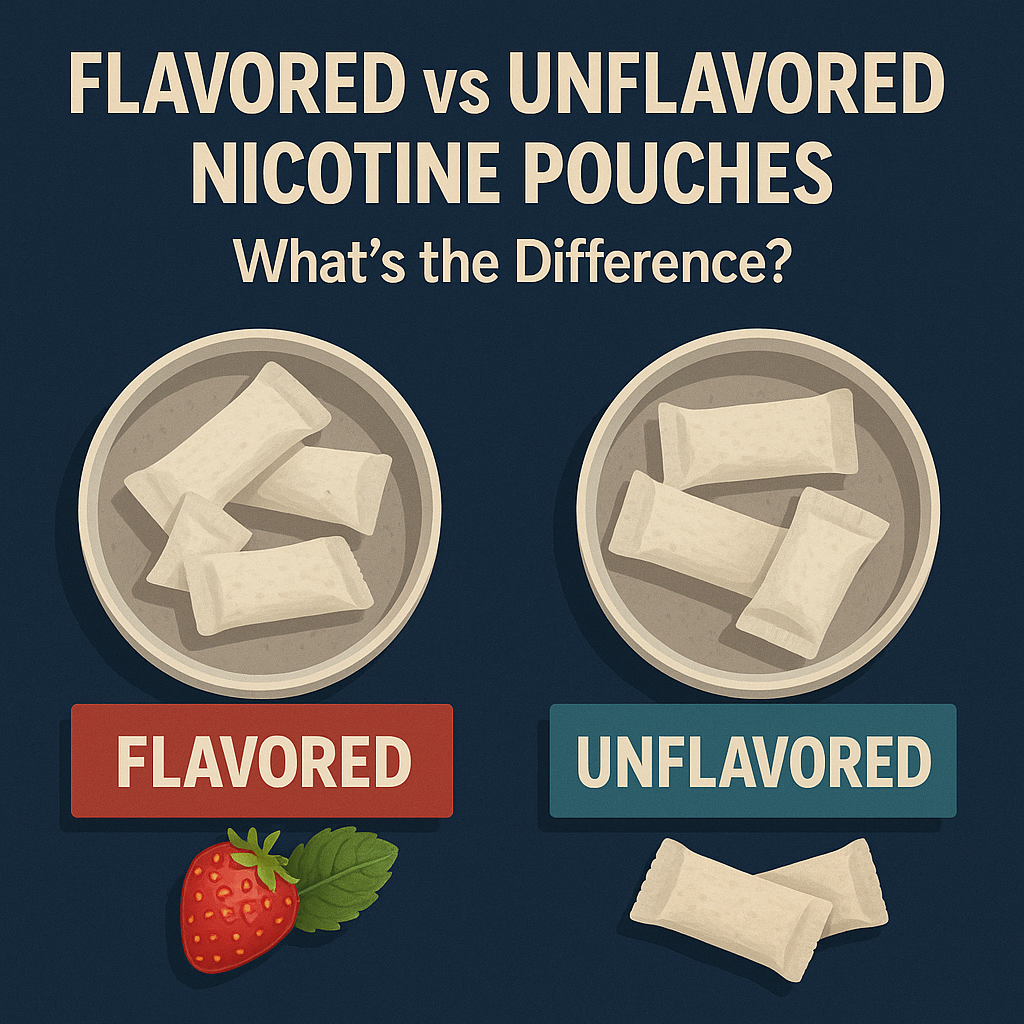
What are Flavored Pouches?
Flavored nicotine pouches include added tastes like:
- Fruit (e.g. berry, citrus)
- Mint or menthol
- Coffee or cinnamon
- Sweeteners or aroma agents
They’re marketed as aromatic and enjoyable.
What are Unflavored Pouches?
Unflavored (or “original”) pouches skip flavorings and focus on pure nicotine. Some brands position these as more “mature” or “neutral.”
However, product lines often blur. Even “unflavored” options like ZYN Chill and Smooth have been shown to include synthetic cooling compounds (WS-3).
The Sales Gap: Flavor Wins by a Landslide
In practice, flavored pouches strongly outperform unflavored ones. U.S. Nielsen data shows flavored pouches outsold unflavored options by a factor of 8-to-1. In 2024, nearly 90% of industry revenue came from flavored products.
Most brands start with crowd favorites like mint, wintergreen, and berry before expanding into more niche flavors. Unflavored options are typically labeled “Original” or “Smooth” and are sold to a smaller, niche segment of the market.
Regional Trends: Flavor Preferences and Regulations
U.S. Market
North America dominated the market in 2024, accounting for 78% of global nicotine-pouch revenue. Flavored pouches remain broadly legal, subject to federal review. In January 2025, the FDA approved 20 ZYN pouch products in 10 different flavors, including Cinnamon, Citrus, and Coffee.
While advertising is tightly regulated to minimize youth exposure, the flavors themselves are still permitted.
FDA focuses on age restrictions and warnings, not banning flavors.
Europe: A Patchwork of Bans
- Belgium & Netherlands: Full bans
- France: Total ban pending
- Denmark: Flavors limited to tobacco/menthol (by 2026)
- Finland: Ban on non-menthol, lower nicotine cap
- Spain: Proposes tobacco-only flavors
Other Markets
In Canada, pouches are classified as tobacco products, and further restrictions on flavors are expected. Latin American countries largely ban or tightly regulate novel nicotine products. In Asia-Pacific, regulation varies; some countries allow synthetic nicotine, while others do not.
Consumer Behavior & Demand Shifts

Rising Sales
- U.S. monthly sales tripled (2021–2024): 327M → 1.046B )
- CDC: Pouch sales up 300× from 2016 to 2021
- ZYN: 50% year-over-year growth (2020–2021)
Why Flavors Drive Growth
Flavors play a big part in this growth, particularly for adult smokers seeking alternatives and young adults who enjoy flavor variety. Studies show mint and fruity flavors are the most popular.
Youth Use: Still Low
Meanwhile, youth usage remains low. According to 2024 FDA data, only 1.8% of U.S. middle and high schoolers reported using pouches.
8 Key Strategic Product Decisions for 2025
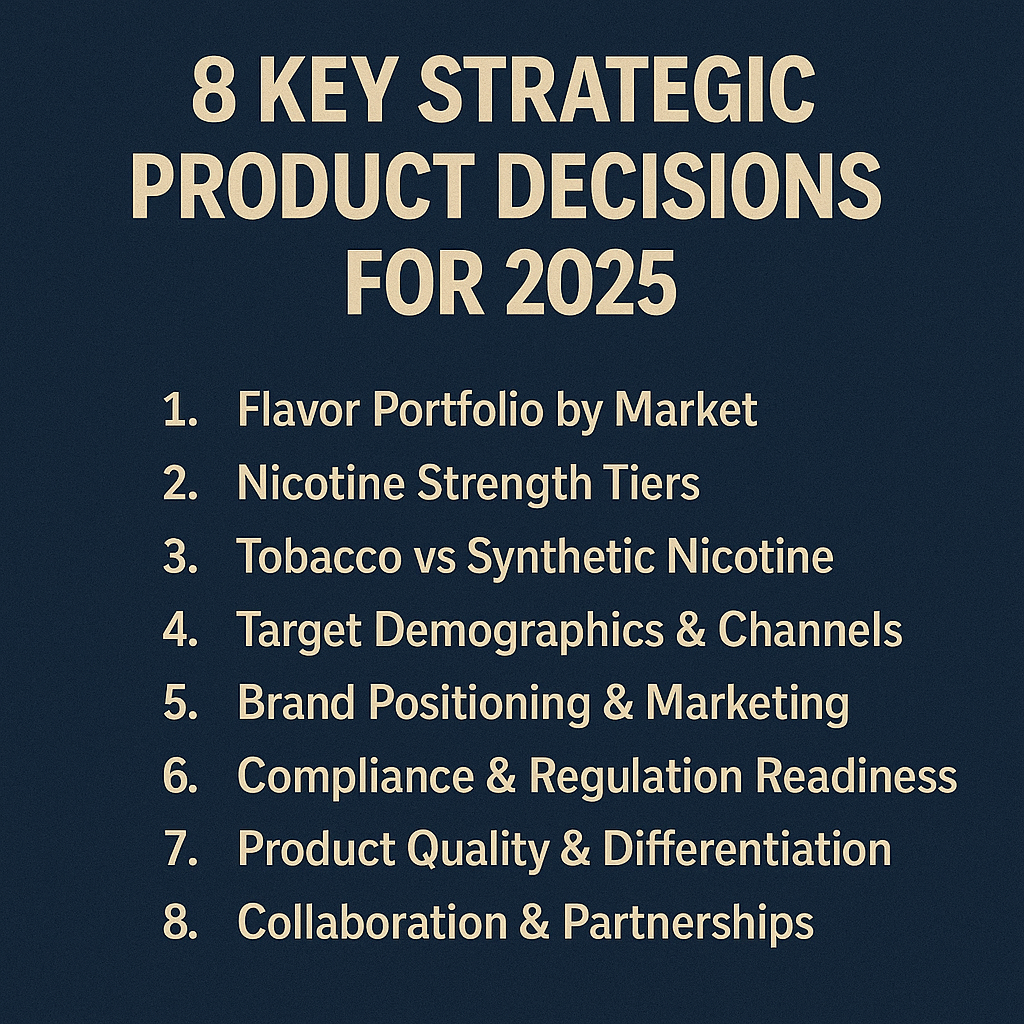
To succeed in this evolving market, consider these crucial steps:
1. Build a Market-Specific Flavor Portfolio
In permissive markets like the U.S. or UK, offer a wide flavor selection: mint, fruit, coffee, cinnamon.
In restricted regions like Spain or Denmark, limit to legally allowed options such as tobacco or menthol. Some brands also use vague names like “Smooth” or “Chill” to remain compliant.
2. Offer Tiered Nicotine Strengths
- Most U.S. sales come from 3–6 mg pouches.
- High-strength options (8–14 mg) are gaining traction
Offer multiple levels:
- Low to medium (2–6 mg)
- High strength (8+ mg) for experienced users
Ensure your manufacturing supports this range.
3. Choose Between Tobacco and Synthetic Nicotine
- 95% of 2024 pouches used tobacco-derived nicotine
- Synthetic nicotine offers flexibility in strict regions
A dual strategy helps reach more markets.
4. Define Target Audience and Sales Channels
Focus your messaging on adult smokers. Avoid youth-targeted branding. For distribution, prioritize:
- Online stores with age verification
- Brick-and-mortar locations (pharmacies, vape shops)
5. Craft a Unique Brand Positioning
Position around these themes:
- Smoke-free lifestyle
- Harm reduction for adult smokers
If data supports it, explore Modified Risk Tobacco Product (MRTP) pathways.
6. Stay Legally Ready
Compliance must be baked into your operation:
- Proper age labeling
- Tamper-proof packaging
- Local tax classifications
- Flexible packaging to adapt to new laws
7. Differentiate Through Product Quality
Stand out with:
- Clean-label claims (organic, additive-free)
- Superior pouch texture
- Variety in size: mini, slim, large
Find your niche between premium and budget pricing.
8. Form Partnerships for Agility
Working with contract manufacturers gives access to small-batch production and flexible formulation changes. Partnerships with flavor houses or nicotine suppliers also help secure reliable ingredient access.
Strong sourcing partnerships = faster innovation.
Adaptations in Flavor Formulation
In flavor-restricted regions, innovation plays a crucial role. Brands often turn to “flavor-ban compliant” sensory additives—like WS-3—to simulate minty or cooling sensations without breaching rules.
Other workarounds include:
- Reformulating cocoa, coffee, or nut notes under “tobacco” flavor labels
- Leaning into menthol if allowed
- Using natural tobacco aromas or savory notes like caramel
Flexibility in R&D is vital. Manufacturers should maintain dual formulations—one for open markets, another for restricted ones. Quick replacement of ingredients helps avoid costly production halts.
Future-Proofing Through Manufacturing
Key Considerations:
- Modular production lines: Quick flavor changes
- Multi-ingredient sourcing: Nicotine, pulp, flavor agents
- Batch customization: Agile short runs
- Scalable tech: Slim/mini/large options
- Regulatory readiness: Editable labels, compliance logs
- Quality control: Sensors, batch testing
In-house? Use lean manufacturing. Or: partner with global producers for geographic flexibility.
Looking Ahead

The nicotine pouch industry is moving quickly—consumer tastes are evolving, and regulations are catching up. To stay relevant, you need more than a solid product. You need a strategy that adapts fast, meets demand, and plays by the rules.
At The Pouch Plug, we’re not just following trends—we’re shaping them. With over 12 years of Swedish expertise, we understand every step of the journey, from ingredient sourcing to regulatory navigation and premium production. The trust in Swedish manufacturing is global, and our roots bring credibility and confidence to every product we help create.
If you’re thinking about expanding your flavor portfolio, entering new markets, or improving your supply chain—we’re already doing it.
Let’s figure out what your pouch lineup should look like next. Reach out here.
FAQ❓
In 2025, mint, wintergreen, and berry remain the top sellers globally. However, niche options like coffee, citrus, and cinnamon are growing fast in trend-forward markets like the U.S. and UK.
Unflavored pouches still represent a small segment—about 10% of sales. They appeal mostly to longtime users or those in regulated markets, but flavored pouches dominate by consumer preference.
Yes, many successful brands start with a few strong flavored SKUs and add unflavored options for flavor-restricted regions. Explore our OEM/ODM services to launch your pouch lineup.
Most U.S. users prefer mid-strength (3–6 mg), but heavy users want 8–14 mg. Your ideal strength range depends on target demographics and market preferences—start with tiered options for flexibility.
Flavor bans vary by country. The EU is tightening restrictions, while the U.S. still allows most flavors. Smart brands build adaptable portfolios and use creative naming to stay compliant.
Look for partners with unique expertise, flexible production capacity, and strong quality control. At The Pouch Plug, we combine 12+ years of Swedish experience with scalable nicotine pouch solutions. Contact us to get started.

